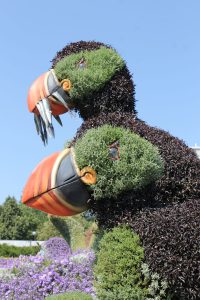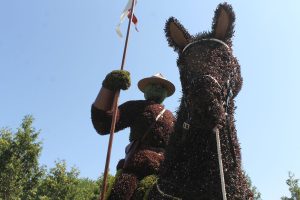MosaiCanada 150
Hi everybody!
Because it is the Summer holidays, I thought I could come back to Canada and visit my friends in the forest and tell them all about my adventures of the past year.
I took the opportunity to visit a special exhibition in Gatineau, right next to Ottawa. This exhibition is called MosaiCanada.
I invite you to board the train and visit the provinces and territories of Canada through mosaiculture. It’s a great way to celebrate 150 years of Canadian history, culture and the arts.
Mosaiculture is a very special horticultural technique that combines sculpture and horticulture. Plants are used as a palette of colours in the creation of sculptures.

Let’s begin our visit of Canada in Newfoundland and Labrador with puffins. Did you know that these birds can barely fly?
Then we go to Nova Scotia with the lobster fisherman.
We continue to Prince Edward Island with its red foxes and the famous character of Anne of Green Gables by Lucie Maud Montgomery.
New Brunswick is known for its horses. Watch the mane of the horse fly in the wind! It’s so beautiful!
And here are the three sailboats that took Jacques Cartier and his crew to Quebec in the 16th century.
The Niagara peninsula is located in Ontario. It is represented by this sculpture with five different faces showing the diversity of Canada.
After Ontario, we arrive in Manitoba. This province is represented by the polar bear.

For Saskatchewan, MosaiCanada decided to represent a Royal Canadian Mounted Policeman on his horse.
We continue the journey through Canada and we arrive in Alberta where we find the wild rose, the floral emblem of this province.
British Columbia is represented by a copy of the famous Haida sculpture of a killer whale by Bill Reid. You can see the original of this sculpture in front of the Vancouver Aquarium and a plaster copy at the Museum of History in Gatineau.
We are moving now to the territories in northern Canada. We start with a giant Inukshuk and a wolf that represent the legend of the Northern Lights.

The Yukon is famous for the gold rush.
In the Northwest Territories, we find muskoxen. See how great and strong they are!
And finally, Nunavut where we see a drum dancer. This is how the ancients would pass the heritage and the stories of their people to the subsequent generations.
There were still many other sculptures but there was one that I liked very much. It is Wisahedjàk and the creation of the world. Look at him in his canoe with all the animals … including a beaver!
At MosaiCanada there are also various animal sculptures such as Canada geese, horses, a deer and a moose. And to finish, the pièce de resistance, a huge sculpture representing the legend of Mother Earth. Admire how the hair is made with different kinds of plants to show movement and shimmering.

Usually, mosaiculture are two-dimensional (like a carpet). But in this case, most mosaics are three-dimensional. Each sculpture is made of a steel structure filled with earth and wrapped in horticultural fabric. When the structure is ready, plants of different textures and colours are planted to make a beautiful living sculpture.
I hope you enjoyed seeing these magnificent sculptures of MosaiCanada. If you are visiting this area, go see them! It’s just beautiful!
Beaverly